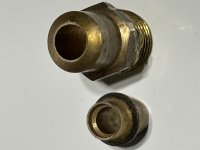When I was growing up, my neighbor owned a factory that produced pipe fittings. These were all made from solid brass or copper. They started with billet and machined away the unwanted parts.
He once explained his business. He claimed he made no money at all on the production of the pipe fittings. That 100% of his profit was in the scrap brass he sold. (They produced a lot of scrap.). I don’t know if that was entirely true, but it reinforced the point that he was in the business of removing material, not assembling components.
The metal grain travels in the direction of manufacture. So if you are proving heavy rods, the grain runs along the length of the rod. It is only likely to bend along that length. It is not going to crack.
That is, if it was produced the traditional way. However, if they have figured out that it is cheaper to join two pieces of brass by brazing, instead of simply machining from a larger piece of solid brass, then parts could crack as described.
I suspect that the Chinese (or Vietnamese, Ceylonese, or whatever-ese they import these from) have figured it is cheaper to braze components together and then machine, rather than machine from a solid billet. In any event, I suspect that these cracking failures are the product of “production efficiencies”, which in this case means more labor but less material.
I bought my hose fittings from Home Depot many years ago. No cracked parts. But I have little faith that Home Depot’s buyers have the self-control to continue to buy the better components if a lower-priced-but-likely-to-fail version is available.

